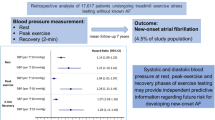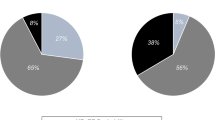Abstract
We tested the hypothesis that the change from the peak to recovery values of systolic arterial pressure (SAPrecovery) and rate–pressure product (RPPrecovery) can be used to predict all-cause and cardiovascular mortality, as well as sudden cardiac death (SCD) in patients referred to a clinical exercise stress test. As a part of the Finnish Cardiovascular Study (FINCAVAS), consecutive patients (n=2029; mean age±SD=57±13 years; 1290 men and 739 women) with a clinically indicated exercise test using a bicycle ergometer were included in the present study. Capacities of attenuated SAPrecovery, RPPrecovery and heart rate recovery (HRR) to stratify the risk of death were estimated. During a follow-up (mean±s.d.) of 47±13 months, 122 patients died; 58 of the deaths were cardiovascular and 33 were SCD. In Cox regression analysis after adjustment for the peak level of the variable under assessment, age, sex, use of β-blockers, previous myocardial infarction and other common coronary risk factors, the hazard ratio of the continuous variable RPPrecovery (in units 1000 mm Hg × b.p.m.) was 0.85 (95% CI: 0.73–0.98) for SCD, 0.87 (0.78–0.97) for cardiovascular mortality, and 0.87 (0.81 to 0.94) for all-cause mortality. SAPrecovery was not a predictor of mortality. The relative risks of having HRR below 18 b.p.m., a widely used cutoff point, were as follows: for SCD 1.28 (0.59–2.81, ns), for cardiovascular mortality 2.39 (1.34–4.26) and for all-cause mortality 2.40 (1.61–3.58). In conclusion, as a readily available parameter, RPPrecovery is a promising candidate for a prognostic marker.
This is a preview of subscription content, access via your institution
Access options
Subscribe to this journal
Receive 12 digital issues and online access to articles
$119.00 per year
only $9.92 per issue
Buy this article
- Purchase on Springer Link
- Instant access to full article PDF
Prices may be subject to local taxes which are calculated during checkout

Similar content being viewed by others
References
Jouven X, Empana JP, Schwartz PJ, Desnos M, Courbon D, Ducimetiere P . Heart-rate profile during exercise as a predictor of sudden death. N Engl J Med 2005; 352: 1951–1958.
Elhendy A, Mahoney DW, Khandheria BK, Burger K, Pellikka PA . Prognostic significance of impairment of heart rate response to exercise: impact of left ventricular function and myocardial ischemia. J Am Coll Cardiol 2003; 42: 823–830.
Vivekananthan DP, Blackstone EH, Pothier CE, Lauer MS . Heart rate recovery after exercise is a predictor of mortality, independent of the angiographic severity of coronary disease. J Am Coll Cardiol 2003; 42: 831–838.
Shetler K, Marcus R, Froelicher VF, Vora S, Kalisetti D, Prakash M et al. Heart rate recovery: validation and methodologic issues. J Am Coll Cardiol 2001; 38: 1980–1987.
Allison TG, Cordeiro MA, Miller TD, Daida H, Squires RW, Gau GT . Prognostic significance of exercise-induced systemic hypertension in healthy subjects. Am J Cardiol 1999; 83: 371–375.
Ciaroni S, Delonca J, Righetti A . Early exercise testing after acute myocardial infarction in the elderly: clinical evaluation and prognostic significance. Am Heart J 1993; 126: 304–311.
Ellis K, Pothier CE, Blackstone EH, Lauer MS . Is systolic blood pressure recovery after exercise a predictor of mortality? Am Heart J 2004; 147: 287–292.
Cole CR, Blackstone EH, Pashkow FJ, Snader CE, Lauer MS . Heart-rate recovery immediately after exercise as a predictor of mortality. N Engl J Med 1999; 341: 1351–1357.
Kato K, Saito F, Hatano K, Noda S, Tsuzuki J, Yokota M et al. Prognostic value of abnormal postexercise systolic blood pressure response: prehospital discharge test after myocardial infarction in Japan. Am Heart J 1990; 119: 264–271.
Fletcher GF, Balady GJ, Amsterdam EA, Chaitman B, Eckel R, Fleg J et al. Exercise standards for testing and training: a statement for healthcare professionals from the American Heart Association. Circulation 2001; 104: 1694–1740.
Elhendy A, Modesto KM, Mahoney DW, Khandheria BK, Seward JB, Pellikka PA . Prediction of mortality in patients with left ventricular hypertrophy by clinical, exercise stress, and echocardiographic data. J Am Coll Cardiol 2003; 41: 129–135.
Elhendy A, van Domburg RT, Vantrimpont P, Poldermans D, Bax JJ, van Gelder T et al. Prediction of mortality in heart transplant recipients by stress technetium-99 m tetrofosmin myocardial perfusion imaging. Am J Cardiol 2002; 89: 964–968.
Elhendy A, Schinkel AF, van Domburg RT, Bax JJ, Valkema R, Poldermans D . Risk stratification of patients after myocardial revascularization by stress Tc-99m tetrofosmin myocardial perfusion tomography. J Nucl Cardiol 2003; 10: 615–622.
Elhendy A, Schinkel AF, Van Domburg RT, Bax JJ, Poldermans D . Prediction of cardiac death in hypertensive patients with suspected or known coronary artery disease by stress technetium-99m tetrofosmin myocardial perfusion imaging. J Hypertens 2003; 21: 1945–1951.
Schinkel AF, Elhendy A, Bax JJ, van Domburg RT, Huurman A, Valkema R et al. Prognostic implications of a normal stress technetium-99m-tetrofosmin myocardial perfusion study in patients with a healed myocardial infarct and/or previous coronary revascularization. Am J Cardiol 2006; 97: 1–6.
Dekany M, Nyolczas N, Reif E, Fiok J, Vandor L, Paksy A . Prognostic value of simple exercise test parameters in patients with dilated cardiomyopathy. Acta Cardiol 1995; 50: 45–52.
Prakash M, Myers J, Froelicher VF, Marcus R, Do D, Kalisetti D et al. Diagnostic exercise tests on 4000 consecutive men. Am Heart J 2001; 142: 127–135.
Villella M, Villella A, Barlera S, Franzosi MG, Maggioni AP . Prognostic significance of double product and inadequate double product response to maximal symptom-limited exercise stress testing after myocardial infarction in 6296 patients treated with thrombolytic agents. GISSI-2 Investigators. Grupo Italiano per lo Studio della Sopravvivenza nell-Infarto Miocardico. Am Heart J 1999; 137: 443–452.
Nieminen T, Lehtinen R, Viik J, Lehtimäki T, Niemelä K, Nikus K et al. The Finnish Cardiovascular Study (FINCAVAS): characterising patients with high risk of cardiovascular morbidity and mortality. BMC Cardiovasc Disord 2006; 6: 9.
Pajunen P, Koukkunen H, Ketonen M, Jerkkola T, Immonen-Räihä P, Kärjä-Koskenkari P et al. The validity of the Finnish Hospital Discharge Register and Causes of Death Register data on coronary heart disease. Eur J Cardiovasc Prev Rehabil 2005; 12: 132–137.
Lauer MS . Exercise electrocardiogram testing and prognosis. Novel markers and predictive instruments. Cardiol Clin 2001; 19: 401–414.
Wichterle D, Simek J, La Rovere MT, Schwartz PJ, Camm AJ, Malik M . Prevalent low-frequency oscillation of heart rate: novel predictor of mortality after myocardial infarction. Circulation 2004; 110: 1183–1190.
Curtis BM, O'Keefe Jr JH . Autonomic tone as a cardiovascular risk factor: the dangers of chronic fight or flight. Mayo Clinic Proc 2002; 77: 45–54.
Watanabe J, Thamilarasan M, Blackstone EH, Thomas JD, Lauer MS . Heart rate recovery immediately after treadmill exercise and left ventricular systolic dysfunction as predictors of mortality: the case of stress echocardiography. Circulation 2001; 104: 1911–1916.
McHam SA, Marwick TH, Pashkow FJ, Lauer MS . Delayed systolic blood pressure recovery after graded exercise: an independent correlate of angiographic coronary disease. J Am Coll Cardiol 1999; 34: 754–759.
Hashimoto M, Okamoto M, Yamagata T, Yamane T, Watanabe M, Tsuchioka Y et al. Abnormal systolic blood pressure response during exercise recovery in patients with angina pectoris. J Am Coll Cardiol 1993; 22: 659–664.
Kurl S, Laukkanen JA, Rauramaa R, Lakka TA, Sivenius J, Salonen JT . Systolic blood pressure response to exercise stress test and risk of stroke. Stroke 2001; 32: 2036–2041.
Laukkanen JA, Kurl S, Salonen R, Lakka TA, Rauramaa R, Salonen JT . Systolic blood pressure during recovery from exercise and the risk of acute myocardial infarction in middle-aged men. Hypertension 2004; 44: 820–825.
Gupta MP, Polena S, Coplan N, Panagopoulos G, Dhingra C, Myers J et al. Prognostic significance of systolic blood pressure increases in men during exercise stress testing. Am J Cardiol 2007; 100: 1609–1613.
Mundal R, Kjeldsen SE, Sandvik L, Erikssen G, Thaulow E, Erikssen J . Exercise blood pressure predicts mortality from myocardial infarction. Hypertension 1996; 27: 324–329.
Acknowledgements
This study was supported by the Medical Research Fund of Tampere University Hospital, the Finnish Cultural Foundation, the Finnish Foundation for Cardiovascular Research, the Academy of Finland (Grant no. 104821), the Emil Aaltonen Foundation, Finland, and the Tampere Tuberculosis Foundation. We thank the staff of the Department of Clinical Physiology for collecting the exercise test data.
Author information
Authors and Affiliations
Corresponding author
Additional information
Conflict of interest
The authors do not have any conflict of interest.
Rights and permissions
About this article
Cite this article
Nieminen, T., Leino, J., Maanoja, J. et al. The prognostic value of haemodynamic parameters in the recovery phase of an exercise test. The Finnish Cardiovascular Study. J Hum Hypertens 22, 537–543 (2008). https://doi.org/10.1038/jhh.2008.38
Received:
Revised:
Accepted:
Published:
Issue Date:
DOI: https://doi.org/10.1038/jhh.2008.38
Keywords
This article is cited by
-
Circadian variation in the circulatory responses to exercise: relevance to the morning peaks in strokes and cardiac events
European Journal of Applied Physiology (2010)
-
Pulse Wave Velocity and Digital Volume Pulse as Indirect Estimators of Blood Pressure: Pilot Study on Healthy Volunteers
Cardiovascular Engineering (2009)



